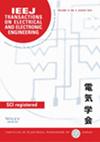求助PDF
{"title":"Power Deposition Characteristics of Electrically Exploding Microscale Metallic Bridges with High-Voltage Pulse-Forming Circuit","authors":"Kyoungjin Kim","doi":"10.1002/tee.70069","DOIUrl":null,"url":null,"abstract":"<p>In various forms of pyrotechnic devices for aerospace and defense systems, the safety and reliability of device functioning heavily relies on the electrical explosion of a thin metallic bridgewire in an exploding bridgewire (EBW) detonator unit for the ignition of primary explosive charges. This study presents the modeling and simulation of pulsed power deposition in a gold bridgewire of micron-sized diameter which undergoes intense joule heating followed by vaporization and bridgewire burst. The present modeling approach is based on the bulk approximation of bridgewire resistance, and it includes the circuit model of a high-voltage charging capacitor discharge unit (CDU) and the energy conservation principle with the consideration of phase changes in the bridgewire. The prediction results are well validated against the EBW firing test measurements in terms of electrical current traces and burst current for a wide range of CDU charging voltages. Threshold charging voltages for bridgewire burst and explosive ignition are investigated for the cases of varying bridgewire diameter and length, which results are found to be consistent with the EBW firing test analysis. © 2025 Institute of Electrical Engineers of Japan and Wiley Periodicals LLC.</p>","PeriodicalId":13435,"journal":{"name":"IEEJ Transactions on Electrical and Electronic Engineering","volume":"20 9","pages":"1474-1480"},"PeriodicalIF":1.1000,"publicationDate":"2025-05-29","publicationTypes":"Journal Article","fieldsOfStudy":null,"isOpenAccess":false,"openAccessPdf":"","citationCount":"0","resultStr":null,"platform":"Semanticscholar","paperid":null,"PeriodicalName":"IEEJ Transactions on Electrical and Electronic Engineering","FirstCategoryId":"5","ListUrlMain":"https://onlinelibrary.wiley.com/doi/10.1002/tee.70069","RegionNum":4,"RegionCategory":"工程技术","ArticlePicture":[],"TitleCN":null,"AbstractTextCN":null,"PMCID":null,"EPubDate":"","PubModel":"","JCR":"Q4","JCRName":"ENGINEERING, ELECTRICAL & ELECTRONIC","Score":null,"Total":0}
引用次数: 0
引用
批量引用
Abstract
In various forms of pyrotechnic devices for aerospace and defense systems, the safety and reliability of device functioning heavily relies on the electrical explosion of a thin metallic bridgewire in an exploding bridgewire (EBW) detonator unit for the ignition of primary explosive charges. This study presents the modeling and simulation of pulsed power deposition in a gold bridgewire of micron-sized diameter which undergoes intense joule heating followed by vaporization and bridgewire burst. The present modeling approach is based on the bulk approximation of bridgewire resistance, and it includes the circuit model of a high-voltage charging capacitor discharge unit (CDU) and the energy conservation principle with the consideration of phase changes in the bridgewire. The prediction results are well validated against the EBW firing test measurements in terms of electrical current traces and burst current for a wide range of CDU charging voltages. Threshold charging voltages for bridgewire burst and explosive ignition are investigated for the cases of varying bridgewire diameter and length, which results are found to be consistent with the EBW firing test analysis. © 2025 Institute of Electrical Engineers of Japan and Wiley Periodicals LLC.
高压脉冲形成电路电爆炸微尺度金属桥的功率沉积特性
在航空航天和国防系统的各种形式的烟火装置中,装置工作的安全性和可靠性在很大程度上依赖于爆炸桥线(EBW)雷管单元中薄金属桥线的电爆炸,用于点燃初级炸药。本文研究了脉冲功率沉积在微米级直径的金桥丝上的过程,该过程经历了强烈的焦耳加热、汽化和桥丝爆裂。该建模方法基于桥线电阻的体积近似,包括高压充电电容放电单元(CDU)的电路模型和考虑桥线相变的能量守恒原理。在广泛的CDU充电电压范围内,预测结果在电流走线和突发电流方面得到了很好的验证。在不同桥丝直径和长度的情况下,对桥丝爆炸和炸药点火的阈值充电电压进行了研究,结果与EBW点火试验分析结果一致。©2025日本电气工程师协会和Wiley期刊有限责任公司。
本文章由计算机程序翻译,如有差异,请以英文原文为准。

 求助内容:
求助内容: 应助结果提醒方式:
应助结果提醒方式:


